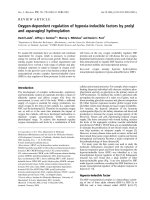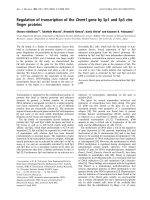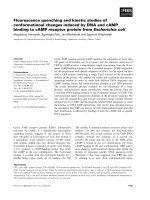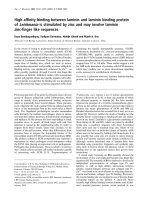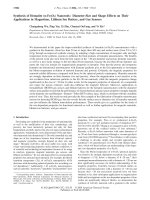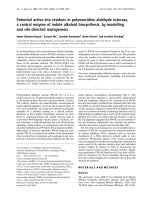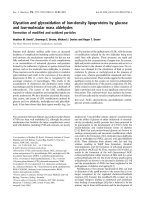Quantification of spheroid formation mechanism by size and shape analysis
Bạn đang xem bản rút gọn của tài liệu. Xem và tải ngay bản đầy đủ của tài liệu tại đây (3.51 MB, 179 trang )
QUANTIFICATION OF SPHEROID FORMATION MECHANISM BY
SIZE AND SHAPE ANALYSIS
CHUA SIANG MENG
B.Sc.(Pharm.)(Hons.), NUS
A THESIS SUBMITTED FOR THE DEGREE OF
DOCTOR OF PHILOSOPHY
DEPARTMENT OF PHARMACY
NATIONAL UNIVERSITY OF SINGAPORE
2008
i
ACKNOWLEDGEMENTS
I am deeply grateful to my supervisors, Assoc Prof Paul Heng and Dr Celine Liew for
their unyielding support and guidance provided during the course of my study.
I wish to thank the National University of Singapore, for providing me with the
opportunity for postgraduate study with a research scholarship.
My appreciation goes to Assoc Prof Chan Lai Wah for her advices on my research
and also for being a supportive mentor to pharmacy’s postgraduate community.
My thanks also go to Ms Teresa Ang, Ms Wong Mei Yin and Mr Peter Leong who
have maintained the laboratories excellently and provided assistance whenever I
needed. Mr Peter Leong has also become a good friend and I cherish this friendship.
My fellow postgraduates in GEA-NUS Pharmaceutical Processing and Research
Laboratory have been a wonderful company to be with. Their kindness and support
have always helped me overcome my many tough challenges. My thanks to my senior
Dr Gu Li for her guidance. I am fortunate to be in the company of Dr Cheong Wai
See, Ms Elaine Tang and Mr Goh Cheong Hian. I will not forget their friendship and
selfless support during the course of my research.
Last but not least, I am indebted to my parents and Zheng Lin for believing in me and
supporting me in whatever I do.
Siang Meng
2008
TABLE OF CONTENTS
ii
TABLE OF CONTENTS
Page
ACKNOWLEDGEMENTS i
TABLE OF CONTENTS ii
SUMMARY vi
LIST OF TABLES ix
LIST OF FIGURES xi
LIST OF ABBREVIATIONS xiii
PART 1. INTRODUCTION 1
1. Spheroids 1
2. Methods of spheroid production 2
2.1. Extrusion-spheronization 2
2.2. Rotary processing 6
3. Process and formulation parameters influencing spheroid formation 7
3.1. Parameters affecting extrusion-spheronization 7
3.2. Parameters affecting rotary processing 9
3.3. Parameters affecting extrusion-spheronization and rotary processing 9
3.4. Influence of formulation 10
4. Contrasting extrusion-spheronization and rotary processing 12
5. Spheroid formation and growth 12
6. Characterization of spheroids 14
6.1. Spheroid size and size distribution 15
TABLE OF CONTENTS
iii
6.2. Spheroid shape 22
7. Size distribution in other particulate systems 23
8. Log normal, normal and mixed Gaussian distributions 24
PART 2. OBJECTIVES 27
PART 3. MATERIALS AND METHODS 29
1. Materials 29
2. Methods 29
2.1. Preparation of spheroids 29
2.2. Spheroid production by ES 31
2.3. Spheroid production by RP 33
2.4. Formation process during ES 33
2.5. Controlled spheroid agglomeration during RP 34
2.6. Drying of spheroids 35
2.7. Characterization of spheroids 35
2.7.1. Size analysis by sieving 35
2.7.2. Sizing by image analysis 36
2.7.3. Roundness quantification by image analysis 38
2.7.4. Crushing strength analysis 39
2.7.5. Moisture content determination 40
2.7.6. Surface roughness analysis 40
2.8. Statistical analysis on spheroid size distributions 41
3. Illustration and quantification of simulated spheroid images 42
TABLE OF CONTENTS
iv
PART 4. RESULTS AND DISCUSSION 44
1. Equivalency in process between ES and RP 44
1.1. Equivalency in spheronization conditions between different frictional
surfaces 46
1.2. Producing RP spheroids of equivalent size and size distribution to ES
spheroids 48
1.3. Effect of processes on size and size distribution of spheroids 49
1.4. Shape of size distribution between ES and RP spheroids 56
1.5. Effect of processes on spheroid roundness 56
1.6. Role of moisture in spheroid formation 57
1.7. Crushing strength of ES and RP spheroids 59
1.8. Visual examination of spheroid formation 61
1.9. Comparison of observed spheroid formation with existing theories 68
2. Mathematical quantification of spheroid formation process 75
2.1. Conventional size and shape characterization methods 75
2.1.1. Sieving 75
2.1.2. Image analysis 76
2.2. Representing ES spheroid size with MG distribution 85
2.2.1. Verifying size distribution of ES spheroids statistically 86
2.2.2. Quantifying spheroid formation with MG distribution 88
3. Relationship between size and roundness of ES spheriods 91
3.1. Sensitivity of roundness descriptors in characterizing spheronization 94
TABLE OF CONTENTS
v
3.2. Correlation between roundness descriptors 95
3.3. Shape heterogenicity within ES spheroid population during spheroid
formation 97
3.4. Novel method in spheroid shape analysis 101
3.4.1. Predominant spheroid shape during spheronization 108
4. Controlled spheroid agglomeration in rotary processor 110
4.1. Representation of RP spheroids with MG distribution 113
4.2. Effects of AGL on spheroid size 116
4.3. Effects of AGL on spheroid roundness 124
4.3.1. Applicability of roundness correlations with RP spheroids 124
4.3.2. Choosing robust spheroid roundness descriptors 127
4.4. Surface changes during spheronization with addition of AGL 132
4.5. Yield 139
PART 5. CONCLUSIONS 142
PART 6. REFERENCES 146
LIST OF PUBLICATIONS/POSTER PRESENTATIONS 163
SUMMARY
vi
SUMMARY
During extrusion-spheronization, extrudates readily break down into fines and broken
cores. The breakdown of the extrudates is followed by extensive layering of the fines.
Extensive layering of fines would occur during spheronization. In contrast, spheroids
produced by rotary processing are formed mainly by nucleation and agglomeration. In
this study, rotary processing produced spheroids used lesser amounts of water for
granulation, as compared to extrusion-spheronization. By appropriate choice of the
spheronization duration and peripheral tip speed, a teardrop studded rotating frictional
plate could produce spheroids with properties equivalent to those produced by the
cross-hatch textured rotational frictional plate. The possible of equivalency between 2
frictional plates that differ in plate surface design allows process engineers to explore
new grounds in equipment design and to transfer know-how in production from
extrusion-spheronization to rotary processing. The loss of moisture during
spheronization was not found to be critical in spheroid formation. Although rotary
processing is a less robust process compared to extrusion-spheronization, good quality
spheroids could still be produced if the distribution of granulation liquid and
movement of powder during wet massing could be improved. The mechanism of
spheroid formation by extrusion-spheronization was found to be related to surface
remodelling and fines layering.
Size analysis of spheroids using sieves was found in this study to lack sensitivity in
detecting subtle size differences as compared to sizing using image analysis. Size
SUMMARY
vii
distribution of spheroids produced by extrusion-spheronization and rotary processing
did not follow normal or log normal distribution. Instead, both processes produced
spheroids which followed a mix Gaussian distribution. These findings offered direct
evidence of spheroid size heterogeneity within a population. During
extrusion-spheronization, dumbbell intermediates were not likely to be formed.
Instead, observations of dumbbells could be a result of coalescence between spheroids
of similar sizes. Compared to conventional methods for computation of spheroid size,
subtle but significant spheroid size changes could be detected if size was represented
by mix Gaussian distribution.
When used alone, circularity (C) was not critical in detecting improvement in
roundness during spheronization. Data from both processes suggested strongly that
eccentricity factor (e
R
) and aspect ratio (AR) were highly correlated with each other.
Therefore, due to mathematical simplicity, AR could be used as a roundness
descriptor instead of e
R
without being less critical in quantifying roundness. The novel
method of using R values of AR-projected sphericity (PS) and AR-C correlations to
distinguish shapes of spheroids such as oval, ellipse and rectangle with round ends
were found to be applicable in both extrusion-spheronization and rotary processing
spheroids. At the end of spheronization, the smaller extrusion-spheronization
spheroids within the population were rounder and these smaller spheroids were also
more variable in shapes, indicating that these spheroids participated actively in mass
SUMMARY
viii
transfer or remodelling. This observation further supported the hypothesis that within
a spheroid population, the size and shape heterogeneity are related.
Prolonged spheronization would alter the surface morphology of spheroids. Addition
of granulating liquid after spheroids were formed would definitely increase the size of
spheroids and also cause a decrease in roundness.
LIST OF TABLES
ix
LIST OF TABLES
Page
Table 1. Recent studies on spheronization and the respective methods used for size,
size distribution and shape characterization. 16
Table 2. Details of equipment used for spheronization of extrudates by ESC and EST.
32
Table 3. Process parameters for ESC and EST batches 32
Table 4. Process parameters for RT batches 33
Table 5. Process parameters and formulations used for controlled agglomeration of
RP spheroids. 35
Table 6. Size, size distribution, roundness, moisture content and crushing strength of
ESC, EST and RT spheroids 46
Table 7. One way ANOVA and post hoc LSD test for variables of ESC, EST, and RT
batches 50
Table 8. Statistical descriptors for size distribution of ESC, EST931 and RT36%
spheroids. 54
Table 9. Mean size and size distribution of ESC(TS) spheroids derived from size
analysis using sieves. 76
Table 10. Mean size and size distribution of ESC(TS) spheroids derived from image
analysis 77
Table 11. One way ANOVA and post hoc test for size and roundness of ESC(TS)
spheroids. 83
Table 12. P values from Chi square curve fitting of size distribution of ESC(TS)
spheroids to various distributions. 86
Table 13. Size distribution of ESC(TS) spheroids as defined by 3cMG distribution 88
Table 15. Correlation coefficient (R) of roundness against ECD of ESC(TS) spheroids.
92
Table 16. Roundness values for different shapes 103
LIST OF TABLES
x
Table 17. Correlation between roundness descriptors for ellipse, oval and RRE 105
Table 18. Size and size distribution of RT(SR) spheroids as characterized by sieving.
112
Table 19 One way ANOVA of size and size distribution of RT(SR) spheroids. 113
Table 20. P values for Chi square curves fitting of size distribution of RT(SR)
spheroids to statistical distributions 114
Table 21. Size distribution of RT(SR) spheroids as defined by 3cMG distribution 118
LIST OF FIGURES
xi
LIST OF FIGURES
Page
Figure 1. Schematic diagrams of (a) a spheronizer and (b) a rotary processor 4
Figure 2. Dimensions of the surface protuberances of (a) cross-hatch and (b) teardrop
studded frictional plates. 5
Figure 3. Schematics showing processes leading to spheroid formation 30
Figure 4. Photographs of time-sampled spheroids depicting stages of spheroid
formation in ESC, EST931 and RT36%. 62
Figure 5. Sequential frames of ESC spheroid formation captured in situ using high
speed video camera 67
Figure 6. Model of spheroid formation by (a) ES and (b) RP. 72
Figure 7. Effect of spheronization duration on (a) e
R
, (b) AR, (c) PS and (d) C of
ESC(TS) spheroids 78
Figure 8. PDF of ESC(TS) spheroids. 79
Figure 9. R values of correlations among roundness descriptors for ESC(TS)
spheroids. 95
Figure 10. Intra lot R values of AR-e
R
and C-AR correlations against ECD of
spheroids (µm). 98
Figure 11. e
R
, AR, PS, C of simulated images plotted against one another. 106
Figure 12. Moisture content of RT(SR) spheroids during RP. 111
Figure 13. Average DI of RT(SR)20 batches and respective DI % changed after AGL
addition. 117
Figure 14. Roundness RT(SR)20 batches and respective roundness % changed upon
AGL addition. 125
Figure 15. R values of roundness correlations for RT(SR) spheroids. 128
Figure 16. Surface roughness of RT(SR) spheroids. 133
LIST OF FIGURES
xii
Figure 17. Surface morphology of RT(SR) spheroids as observed under scanning
probe microscopy 135
Figure 18. Yield for RT(SR) processes 140
LIST OF ABBREVIATIONS
xiii
LIST OF ABBREVIATIONS
AGL – Additional granulation liquid
AR – Aspect ratio
C – Circularity
cMG – Components mixed Gaussian
DI – Arithmetic mean diameter
DIgeo – Geometric man diameter
DImed – Median diameter
Dwarith – Arithmetic weight mean diameter
Dwgeo – Geometric weight mean diameter
Dwmed – Mass median diameter
ECD – Equivalent circle diameter
e
R
– Eccentricity factor
ES – Extrusion-spheronization
ESC – Extrusion-spheronization with cross-hatch plate
ESC(TS) – Extrusion-spheronization with cross-hatch plate (Time
sampling)
EST – Extrusion-spheronization with teardrop studded plate
LSD – Least square difference
MCC – Microcrystalline cellulose
PDF – Population density function
PS – Projected sphericity
LIST OF ABBREVIATIONS
xiv
RP – Rotary processing
RT – Rotary processing with teardrop studded plate
RT(SR) – Rotary processing with teardrop studded plate (Spray rate)
S630 – Copovidone
SDI – Arithmetic standard deviation
SDwarith – Arithmetic weight standard deviation
SDwgeo – Geometric weight standard deviation
SpanI – Span derived from image data
Spanw – Span derived for sieving data
R – Pearson correlation
Ra – Arithmetic average roughness
RRC – Rectangles with round corners
RRE – Rectangles with round ends
Tween 80 – Polysorbate 80
xv
PART 1.
INTRODUCTION
INTRODUCTION
Page 1
PART 1. INTRODUCTION
1. Spheroids
Granules are generally physically and chemically less prone to changes compared to
powders. Granules are easier to handle, possess better flow and are less likely to cake
or harden on storage (Schwartz, 1988). Spheroids are a subset of granules. They are
free flowing spherical granules, commonly of size between 0.5-1.5 mm (Sellassie,
1989a). Hence they possess certain properties which are advantageous over
irregularly shaped granules. These properties include narrow size distribution,
uniformity in shape, low friability, better packing and better flow (Conine and Hadley,
1970; Reynolds, 1970; Robinson and Hollenbeck, 1991). Spheroids are the desirable
choice for capsule filling as they possess good flow properties and are resistant to
breakdown during handling.
The spherical shape allows spheroid coating to be carried out efficiently. Controlled
released dosage forms can be made with drug-loaded cores and release modifying
coatings. Drugs which are incompatible with one another can be placed in the same
capsule by first formulating the different drugs into different spheroids and
subsequently applying coating on the spheroids to function as a protective layer.
Compared to single unit dosage forms, these multiparticulate systems offer
advantages such as improved bioavailability, consistency in gastric emptying rate and
INTRODUCTION
Page 2
less variability in intra-subject and inter-subject drug plasma profiles. Occurrences of
dose dumping effects can also be minimized (Sellassie et al., 1985; Sellassie, 1994).
2. Methods of spheroid production
Depending on the ways particles are brought together, spheroids could be produced
by three general techniques (Sherrington and Oliver, 1981a; Sellassie, 1989b),
a) globulation - spray drying, spray congealing, cryopelletization,
b) compaction, and
c) agitation - solution or suspension layering, powder layering, balling, high shear
pelletization and rotary processing.
Being a multi-step process, extrusion-spheronization (ES) can be classified as a
combination of compaction and agitation. ES is currently one of the most popular
methods of producing spheroids.
2.1. Extrusion-spheronization
ES could be broadly described by these steps: wet massing, extrusion, spheronization
and drying. In general, powders are premixed prior to wet massing. Mixing and wet
massing could be carried out simultaneously in mixer granulators such as planetary
mixers, sigma blade mixers, high shear mixers and continuous granulators (Vervaet et
al., 1995). During wet massing, a moistening agent is added to the powder mixture in
INTRODUCTION
Page 3
order to produce a homogenous wet mass. The moistening agent is usually water but
other binders have also been used to produce spheroids (Umprayn et al., 1999). The
wet massing step is usually followed by extrusion within a short time interval.
However, some research groups have also allowed the wet mass to stand for a few
hours to facilitate moisture equilibration prior to extrusion (Fielden et al., 1989;
Newton et al., 1992).
In the extrusion step, pressure is exerted on the wet mass, forcing it to flow through
orifices of the extrusion die. As such, the wet mass is densified and shaped into
cylindrical aggregates termed as extrudates. Types of extruders are classified
according to the design of the die and the wet mass conveying mechanism (Fielden
and Newton, 1992). The different types of extruders include ram, screw, radial screen,
roll, gravity feed, sieve and basket extruders. Different types of extruders would exert
varying degree of densification onto the wet mass (Sherrington and Oliver, 1981b).
Specialized equipment such as the twin screw extruder could carry out mixing, wet
massing and extrusion in a single step (Linder and Kleinebudde, 1994).
Spheronization is carried out in a spheronizer after extrudates are produced.
Extrudates within the product chamber of the spheronizer experience frictional forces
exerted by the rotating frictional plate (Figure 1).
INTRODUCTION
Page 4
(a)
(b)
Figure 1. Schematic diagrams of (a) a spheronizer and (b) a rotary processor
Typically, the surface texture of the rotating frictional plates is made up of a
cross-hatch pattern of square pyramidal studs with rectangular grooves (Figure 2).
The plate can also be of a radial pattern, consisting of rectangular grooves radiating
from the center of the plate. It has been reported that cross-hatch or radial textured
rotating frictional plates did not affect spheroid quality unless the extrudates were of
Inner chambe
r
Ga
p
ai
r
Spray gun
Rotating frictional
plate (with
teardrop studs)
Fluidizing
chamber
Rotating frictional
plate (with
cross-hatch
p
atterned
g
rooves
)
INTRODUCTION
Page 5
poor quality (Newton et al., 1995a). During spheronization, the sharp edged texture of
the rotating frictional plate breaks up the cylindrical extrudates into shorter segments
as they tumble around the spheronizer in a rope like motion. With prolonged tumbling,
these shorter segments would be rounded, forming spheroids.
(a)
(b)
Figure 2. Dimensions of the surface protuberances of (a) cross-hatch and (b) teardrop
studded frictional plates.
8 mm
2 mm
Top view
14 mm
12
mm
Side view
Cross section
0.5 mm
Top view
1mm
1mm
Side view
Cross section
1mm
INTRODUCTION
Page 6
Spheroids are commonly dried either by using hot air ovens or by fluid-bed driers.
These two methods have been compared by Dyer et al. (1994). Other drying methods
include microwave drying (Bataille et al., 1993) and freeze drying (Kleinebudde,
1994).
2.2. Rotary processing
Rotary processing (RP) is alternative method to produce spheroids. The main
difference between ES and RP is that the former is a multi-step process while the
latter is a “one pot” process. Different terms have been used to describe the equipment
for RP. These include centrifugal equipment/granulator, rotary fluidized bed
granulator, rotary processor and rotor granulator (Figure 1). During RP, liquid
addition, wet massing, agglomeration and spheronization would take place
simultaneously. Like the spheronizer, the rotary processor has a product chamber with
a rotating frictional plate located at the bottom (Figure 1). However, the texture of its
rotating frictional plate differs from that of the typical spheronizer. The protrusions on
the plates of the rotary processor are generally rounded with less well-defined edges,
e.g. in the shape of teardrops (Figure 2) or truncated pyramids. Unlike the spheronizer,
the rotating frictional plate of rotary processor has been designed to fulfill a wider
range of requirements: transporting powders around the rotary processor, transporting
aggregates around the rotary processor, densifying aggregates, breaking down
excessively large aggregates and rounding of aggregates. Within the product chamber,
the rotary processor has a spray gun to introduce granulating liquid to the powder
INTRODUCTION
Page 7
mixture. The wall of the product chamber can be elevated, allowing materials to move
outwards by centrifugal forces when they are agitated around the product chamber by
the rotating frictional plate to the fluidizing zone. Hot fluidizing air is passed through
the fluidizing zone to dry the materials. Another difference between a rotary processor
and a spheronizer is the presence of gap air in a rotary processor. Pressurized air,
termed gap air, is introduced from the bottom of the product chamber of the rotary
processor through the clearance between rotating friction plate and the product
chamber wall. At the beginning of RP when the powder mixture is still dry, the
powder mixture can slip through the clearance between the rotating frictional plate
and the product chamber when the plate rotates. The gap air prevents the slippage of
powders through the clearance.
3. Process and formulation parameters influencing
spheroid formation
The parameters affecting spheroid formation can be divided into three groups. The
first group affects exclusively ES. The second group affects exclusively RP. The third
group affects both ES and RP.
3.1. Parameters affecting extrusion-spheronization
The type of extruder used can affect the resultant spheroids. Compared to a rotary ring
die press, a twin-screw extruder required a higher amount of water for producing
INTRODUCTION
Page 8
spheroids of equivalent size (Schmidt and Kleinebudde, 1998). Using a radial
extruder, Vervaet and Remon (1996) investigated the effects of two different impeller
designs and three different screen perforation geometries on the quality of spheroids
produced. Their results showed that the impeller design and screen perforation
geometry affected the maximum amount of lactose to be used as filler. Thoma and
Ziegler (1998) researched on the optimum amount of water required for making
spheroids using roll, axial and radial extruders. Among these types of extruders, the
roll extruder required the least amount of water for successful spheroid formation.
While the axial extruder tolerated the widest range of water concentration for
successful spheroid formation, the maximum allowable water concentration for
extrusion for the axial extruder was also the highest among the three extruders.
Extrudates produced by the axial extruder were the densest, thus improving their
ability to retain water within the matrix, resulting in a decrease in the amount of
excess water on spheroid surfaces. This, in turn, reduced the tendency for excessive
agglomeration during spheronization. Larger spheroids could be produced if a thicker
screen was used (Hellen et al., 1993). Instead of evaluating extrusion performance by
assessing the quality of spheroids produced, Shah et al. (1994 and 1995) investigated
extrusion performance using an instrumented extruder. Extrudability of wet mass
could be determined by the screen temperature and pressure (Shah et al., 1994). The
yield of spheroids of size 710-1000 µm could be controlled by the screen pressure.
Yield and tensile strength of wet mass were also able to affect the shape factor of
spheroids (Shah et al., 1995).
INTRODUCTION
Page 9
3.2. Parameters affecting rotary processing
With sufficient amount of water for spheronization, an increase in spray rate would
increase the spheroid size (Wan et al., 1994) whereas the rate of water addition during
wet massing would not be an issue with ES. An increase in gap air pressure reduced
the size of spheroids produced (Wan et al., 1994). Vertommen et al. (1998) attributed
the influence of gap air pressure to the amount of water loss during water addition.
3.3. Parameters affecting extrusion-spheronization and rotary
processing
A longer duration for spheronization allows an increased opportunity for
agglomeration to take place. However, longer durations might cause spheroid size to
decrease if spheronization speed is excessively high, promoting breakdown (Wan et
al., 1993).
Spheronization at low speed would yield spheroids with poor form factor due to
insufficient frictional forces to round them. Above a certain threshold speed, generally
round spheroids can be formed (Wan et al., 1993). As spheronization speed increases,
spheroid size increases to a maximum. Interplay of agglomeration and breakdown
govern the size of resultant spheroids. Increase in spheronization speed promotes
agglomeration. However, if spheronization speed is excessively high, the tendency for
spheroids to breakdown is greater than to agglomerate, leading to a decrease in
spheroid size (Wan et al., 1993).


